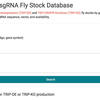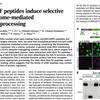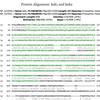Drosophila (fly)
Francois Payre's plenary talk at ADRC 2017 features results from DRSC cell-based screen
. 2015. “Pri sORF peptides induce selective proteasome-mediated protein processing.” Science, 349, 6254, Pp. 1356-8.Abstract
New automated imaging at the DRSC
. 2016. “Seipin is required for converting nascent to mature lipid droplets.” Elife, 5.Abstract
New stocks added to the TRiP in vivo RNAi library
CRISPR sgRNA design tool now based on Drosophila genome assembly 6
. 2016. “Genome-Wide RNAi Screening to Dissect the TGF-β Signal Transduction Pathway.” Methods in Molecular Biology. Publisher's VersionAbstract
DIOPT 6.0 released -- with eggNOG and paralog searches added
Now Available: Our 2017 NAR database issue update
. 10/11/2016. “FlyRNAi.org—the database of the Drosophila RNAi screening center and transgenic RNAi project: 2017 update.” Nucleic Acids Research. Publisher's VersionAbstract
. 10/31/2016. “Loss-of-function genetic tools for animal models: cross-species and cross-platform differences.” Nat Rev Genet. Publisher's VersionAbstract







